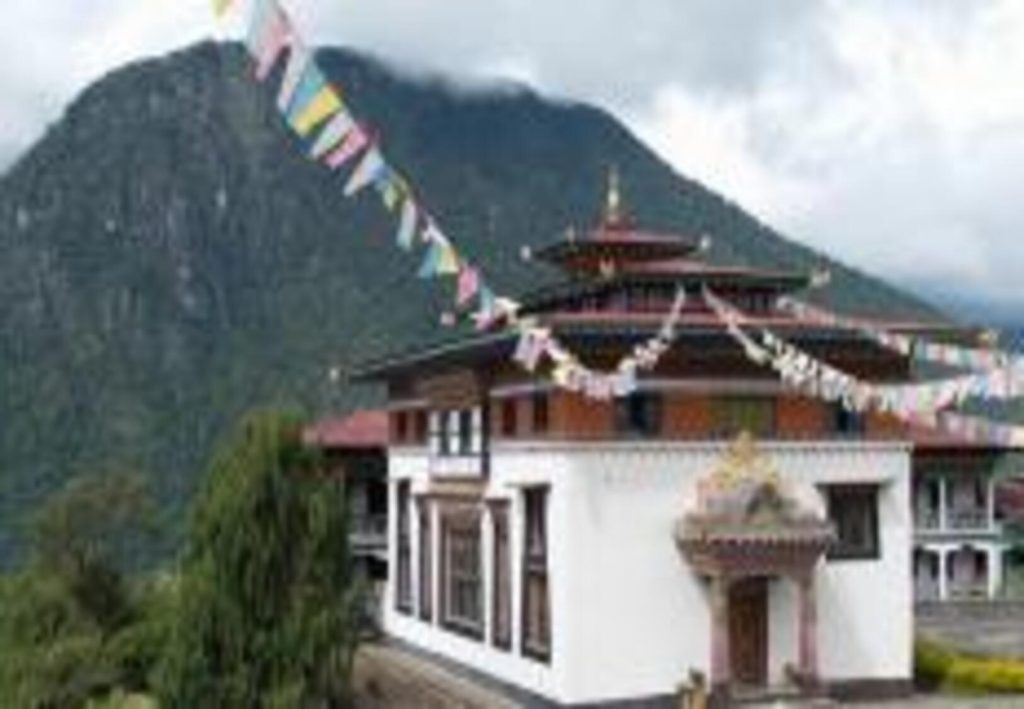Radhi
Radhi is located some 27 km east of Trashigang Dzongkhag on a north facing slope. It is partly a dry Chirpine belt in its lower part and the upper part is covered with a cool broadleaf forest. It is drained mainly by two small rivers systems, namely Chongdiri in the east and Yudiri in the west. It covers 29 square km within an altitude ranging from 1,080 masl to 3,220 masl. The monthly average temperature varies between 12 degree Celsius to 22 degree Celsius and the average annual rainfall is 1,353 mm and is a part of the Gamrichu watershed.
The Gewog is surrounded by the pastoral dominated Gewog of Merak in the south-east and mixed pastoral and arable farming in the Phongmey and Shongphu Gewogs in the east and west respectively. The small commercial town of Rangjung is in the south-west of the Gewog. It is famous for its rice and Radhi-Buray textiles. The main agricultural crops that are grown by people of Radhi are paddy, maize, soyabean, potatoes and vegetables which are mostly used for household consumption except for rice which is mostly sold. Radhi is a relatively small geog, it has 21 villages viz Tsangkhar, Dekiling, Dungsam, Radhi Pangthang, Khudumpang, Jonlapam, Jonla Tsatse, Tangthrang, Bongman, Chema, Melongkhar, Tsamang, Tonglingpam, Khatoe, Kadam, Drung Gonpa, Langteng, Tokshingmang,Naktshang, Phajogonpa, Langteng Sotshong with 758 households and total population of 5834.
The gewog has total number of 8 Lhakhangs and a Nunnery Institution. 6 of them are public owned and 2 of them are owned by private Kuenzang Theckcho Choden Nunnery Institute was established by Dungzin Garab Rinpoche in the year 1991. It is located at Khardung village under Radhi Gewog. Presently the institute has 105 nuns, 2 Khempos, 4 teachers and a Lama making offerings and residing in the institute. They make offering and perform rituals for the well being of the people and sustaining harmony, peace and prosperity in the country and the king. Namdrol Choling Lhakhang was established in the year 1908 by the initiative of Dronyer Ugyen Dorji and labour contribution from the people of Tshangkhar and Bongman villages. Before the Lhakhang is benefiting two villages but now the Lhakhang is spiritually benefiting seven villages via Tshangkhar, Melongkhar, Bongman, Chema, Radhi Pangthang, Dekiling and Langteng. They perform different celebrations and ceremonies on special occasions in this Lhakhang, by contributing labour and financial assistance from the people of the Benefited villages.
Gewog Profile Radhi Gewog 2023
Population and land use
Area(Sq. Km) 29
Km from Dzongkhag head Quarter to Gewog center 27
Population Figure Total 5834
Male 2888
Female 2946
population Density ( per Sq. Km) 201.17241
Administrative units
Gewog Center 1
Chiwogs 5
No of villages 21
No of Gongtong 136
RNR Center
RNR Center 1
Range office 1
Piggery Farm 0
Poultry farm 3
Milk Processing unit 0
Active/ registered Farmers Group 3
No of community forestry 2
No of Farm Road 30
Length of farm Road in Kms 83.6
No of electric fencing 22
length of electric fencing in Kms 51.43
No functional of Irrigation channel 22
length of functional Irrigation channel 56.5
Health Center
Hospital 0
No of BHU1 0
No of BHU 11 1
ORC with shade 4
Education
Higher secondary school 0
Middle secondary school 1
Lower secondary school 0
Primary school 2
Extended classroom 0
Non formal education center (NFE) 1
Early Child Development Center(ECCD) 2
Religion and culture
No of community own Lhakhang 9
No of Government lhakhang 0
No of Private own Lhakhang 0
No of chortens 96
Bridges
Total number of motorable bridge 1
Total number of Non-motorable bridge 4
Sl No Chewog name Male Female Total
1 Pakaling 204 234 438
2 Dekeling_Tshengkhar 366 360 726
3 Tongling_pam 239 227 466
4 Kadam 170 162 332
5 Naktashang_Tongshingmang 190 194 384
Institutions
No institutions in this Gewog.
Staff

Yonten Phuntsho
Radhi Gup

Rinchen Wangdi
Radhi Mangmi

Yonten Nima
Radhi, Kadam Tshogpa

Karma
Radhi, Tokshingmang Tshogpa

Pema Tenzin
Radhi, Dekiling-Tshangkhar Tshogpa

Sherub Jamtsho
Radhi, Tongling-Pam Tshogpa

Tashi
Radhi, Pakaling Tshogpa

Pema Wangchen
Radhi, Agriculture Extension Officer

Tashi Norbu
Radhi,Livestock Extension Officer

Karma Yangki
Radhi, Gewog Administrative officer

Karma Lhaden
Radhi, Community center

Sherab Zangmo
Radhi, Range Officer

Passang Gyeltshen
Radhi, Gewog Driver

Karma
Radhi, Gewog Caretaker
Tourism
Contact us
-
Dzongkhag Administration
Trashigang, Bhutan -
+975 04521387 -
trashigang@trashigang.gov.bt

